Hockey drills for technique passing
- Position the pawns as shown in the figure
- Spread the balls on pylons C and D.
- In this exercise you place a player on the pylons C and D.
- The rest of the team lines up at the A-post.
- From A the player walks around the pylon
- From the pylon, the player makes a sideways movement, facing the ball (facing C)
- Player C plays the ball into the forehand of A
- A takes the ball and turns to the right to open
- A runs towards the circle and finishes on goal.
- From here he runs to D and receives another ball.
- The player turns open to the left and again finishes on goal.
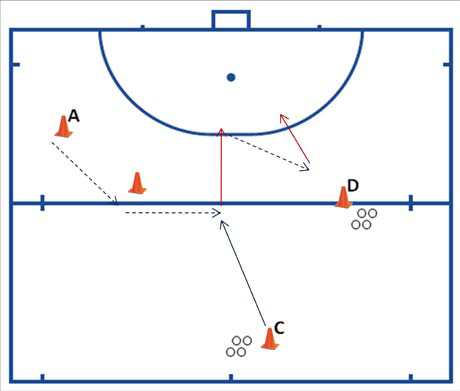

Two teams with substitutes, substitutions are made when a goal is scored.
Each person defends a goal, on each field there are 5 goals, so there are also 5 people who defend these goals.
If a goal is scored in your goal, you have to sit on the sidelines and you become a substitute. A new player (substitute) from the side enters the field and will defend the goal.
If a goal is scored, it is 1 point. The team that has the most points at the end of the game is the winner.
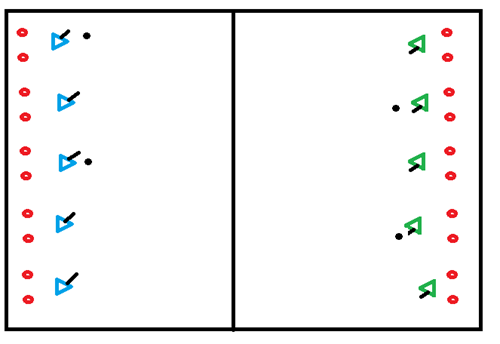
Overplaying to score
Two players continuously play over the ball until one student is so close to the goal that he can score in the goal.
Variation 2-1 situation:
Under pressure from the defender, the attackers must now play together and try to score. The defender can score a point by conquering the ball and then dribbling over the dead ball line. This is the short side without a goal.
Overplaying to score
Two players continuously play over the ball until one student is so close to the goal that he can score in the goal.
Variation 2-1 situation:
Under pressure from the defender, the attackers must now play together and try to score. The defender can score a point by conquering the ball and then dribbling over the dead ball line. This is the short side without a goal.
- A starts with the ball.
- B runs in and gets the ball from A in the run.
- B runs on but meets a defender and passes the ball back to A.
- B then accelerates wide and gets the ball back from A immediately.
- B completes his line and walks in and around the circle with a shot for goal.
- Expanding on two sides
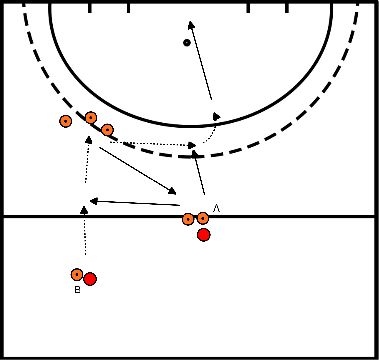
- A gives a hard pass to B
- B slaloms between pawns with the ball A slaloms between pawns WITHOUT the ball
- B gives a hard pass at the end towards A who takes the ball in the run
- A aligns the ball and finishes with the backhand on goal
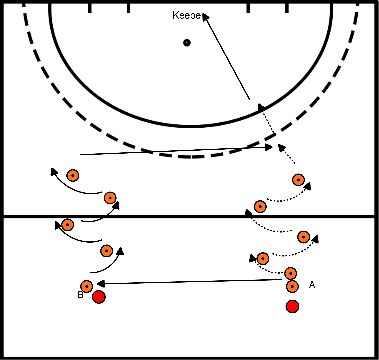
- A pushes the ball to B
- B takes the ball and passes (2 touch)
- B pushes the ball through to C who takes the ball closed
- Who then turns left or right and finishes on goal
- Same on the other side
- You stay with B and A once
- First you give the ball and then you receive the ball and then you pass through
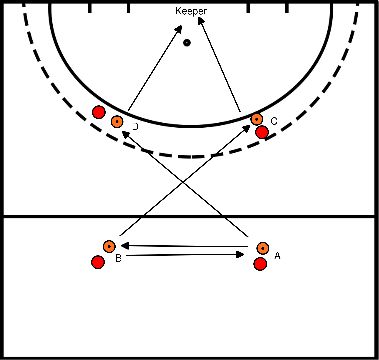
- aim pass at each other's forehand
- run to the ball you passed
- shoot at goal
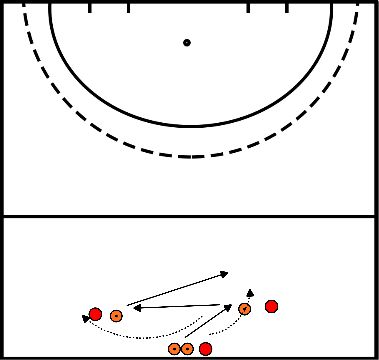
- Exercise with different lift passes.
- A runs to the bar and passes over the bar and gives a pass to B.
- B runs towards the ball and gives a lift pass to A.
- A has gone through to take the ball from B.
- A gives a hard flat towards C.
- C comes in front of the bar and lifts the ball in a movement over the beam bar accelerates towards the circle.
- C ball on the stick enters the circle.
- Aligning ball and shooting at goal
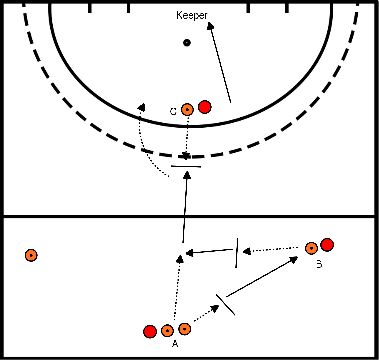
- Player 1 plays ball on player 2.
- player a runs on and receives the ball back, player 1 now plays ball on player 3 and receives the ball back again and shoots the ball at goal.
- variation:
- instead of shot on goal,
- gives player 1 a pass for the goal on player 4
- player 1 takes the place of player 4.
- player 2 and 3 remain.
The pass to the right goes diagonally forward and over the backhand side of the defender, the pass to the left you play wide and goes over the forehand side of the defender.
Therefore the pass to the right is preferred over the pass to the left.
- This is a basic exercise in preparation.
- Just like a tennis player who prepares for training with basic strokes, the players must prepare for the complex training and competition forms, with direct simple passes on top of each other.
- In this way, the trainer has the ability to see technical errors in each individual player and correct them as early as the basic exercise.
- The players pass the ball directly between two pylons and walk counter-clockwise to the other side.
- The size of the target and the distance between the players will be adjusted according to the age and level of the players.







